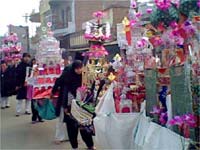Just In
- 7 hrs ago

- 16 hrs ago

- 17 hrs ago

- 18 hrs ago

Don't Miss
- Finance
 Biggest Ever Stock Splits, 49 New Shares On Existing 1 Share; FMCG Makes Big Announcement Before Splitting
Biggest Ever Stock Splits, 49 New Shares On Existing 1 Share; FMCG Makes Big Announcement Before Splitting - Sports
 Pakistan vs New Zealand 4th T20I Match Preview, Key Players, Injury Update, Squad, Other Details
Pakistan vs New Zealand 4th T20I Match Preview, Key Players, Injury Update, Squad, Other Details - Education
 JEE Main Result 2024 Out, Telangana's 15 Toppers Shine, Check Statewise List of 56 Candidates with Perfect 100
JEE Main Result 2024 Out, Telangana's 15 Toppers Shine, Check Statewise List of 56 Candidates with Perfect 100 - News
 Mangalsutra Row: Did Indira Gandhi Donate Gold During The 1962 War? The Facts Behind Priyanka's Claim
Mangalsutra Row: Did Indira Gandhi Donate Gold During The 1962 War? The Facts Behind Priyanka's Claim - Movies
 Kota Factory 3 OTT Release Date, Platform: When Will Jitendra Kumar's Web Series Premiere On Netflix?
Kota Factory 3 OTT Release Date, Platform: When Will Jitendra Kumar's Web Series Premiere On Netflix? - Travel
 Escape to Kalimpong, Gangtok, and Darjeeling with IRCTC's Tour Package; Check Itinerary
Escape to Kalimpong, Gangtok, and Darjeeling with IRCTC's Tour Package; Check Itinerary - Technology
 OPPO Find X7 Ultra Camera Deep-Dive: Pushing the Boundaries of Photography on a Smartphone
OPPO Find X7 Ultra Camera Deep-Dive: Pushing the Boundaries of Photography on a Smartphone - Automobiles
 Aston Martin Vantage Launched In India At Rs 3.99 Crore
Aston Martin Vantage Launched In India At Rs 3.99 Crore
10 Muharram-Types Of Mourning

The history of Muharram is remembered on 10 Muharram. Though it is followed by all Muslims at large, the Shia sect are the ones who closely observe it.
Different types of mourning are attributed to observing 10 Muharram by different sects of Islam.
'Twelver', which forms the largest branch of the Shia sect of Islam, has its mourners of its three traditional schools, Usooli, Akhbari and Shaykh, gather in a congregation. They render poetic recitations, in the memory of Hazrat Imam Hussain. They lament with the beating of drums and chanting of ' Ya Husan'. The death of Hazrat Imam Hussain is also enacted.
'Alevi',
another
sect
of
Shia
Muslims
keep
a
fast
from
the
first
ten
or
twelve
days
of
Muharram.
They
wear
black
and
abstain
themselves
from
any
form
of
entertainment.
They
even
do
not
resort
to
shaving.
Earlier
they
were
even
forbidden
to
bathe
and
change
their
clothes,
however,
most
of
them
do
not
follow
this
practice.
This
is
called
"Muharrem
Matemi",
"Yas-i
Muharrem" or
"Muharrem
orucu"
The 'Mustaali' group's mourning bears similarity to Twelvers.
Free meals called the 'Nazar' are provided by the mosques on certain nights of Muharram to all. It is considered holy to partake the food as it is consecrated in the name of Allah, Imam Hussain and humanity.
Pilgrimage to Hazrat Immam Hussain's Shrine
Many people of the Shia branch also make a pilgrimage to the shrine of Hazrat Imam Hussain in Karbala. It is considered as one of the holiest pilgrimage centres, apart from Mecca and Medina.
Matam
Matam is another type of mourning. Many Muslims congregate in public and beat their chest, Matam, as a sign of revealing their grief in remembrance of the martyrdom of Hazrat Imam Hussain on 10 Muharram.
Some people apply knives or razors swung on chains on their chests.
Taziya
In
Iran,
theatrical
enactment
of
the
'Battle
of
Karbala'
is
called
as
Taziya.
However,
in
South
Asia,
it
came
to
be
termed
as
a
miniature
mausoleums
that
are
used
in
processions
held
during
Muharram.
It
came
to
be
termed
thus,
owing
to
the
distance
between
India
and
Karbala,
which
was
an
obstacle
in
realising
the
wish
of
Indian
Shi'is
being
buried
near
the
sacred
tomb
of
Hazrat
Imam
Hussain,
or
make
a
pilgrimage
to
Karbala.
Soil from Karbala is brought and sprinkled on the land where future burial is planned. Then Taziya or miniature mausoleums are created and taken in procession during Muharram. They may be buried in the Karbala (the allotted, sanctified land) on 'Ashura', or 10 Muharram.
Let us understand the significance of different types of mourning attributed to 10 Muharram, considered an important Islamic holiday.
-
 faith mysticismRamadan 2023: List Of Healthy Food Items To Consume During Suhoor
faith mysticismRamadan 2023: List Of Healthy Food Items To Consume During Suhoor -
 festivalsEid-e-Milad 2020: A Day Dedicated To Prophet Muhammad's Teachings
festivalsEid-e-Milad 2020: A Day Dedicated To Prophet Muhammad's Teachings -
 faith mysticismHow Is Bakr Eid Celebrated?
faith mysticismHow Is Bakr Eid Celebrated? -
 festivalsUnderstanding What Zakat Is & How It Helps Everyone Celebrate Eid
festivalsUnderstanding What Zakat Is & How It Helps Everyone Celebrate Eid -
 festivalsEid-ul-Fitr, 2018
festivalsEid-ul-Fitr, 2018 -
 thoughtImportant Teachings of Islam
thoughtImportant Teachings of Islam -
 festivalsThe Importance Of Ramadan (May 17 To June 16)
festivalsThe Importance Of Ramadan (May 17 To June 16) -
 festivalsEid al-Adha 2021: Important Things To Do On Bakrid
festivalsEid al-Adha 2021: Important Things To Do On Bakrid -
 festivalsEid-Ul-Fitr 2020: How to Celebrate This Holy Occasion
festivalsEid-Ul-Fitr 2020: How to Celebrate This Holy Occasion -
 festivalsSignificance Of Zakat In Islam
festivalsSignificance Of Zakat In Islam -
 lifeFamous Celebs Who Converted Into Islam
lifeFamous Celebs Who Converted Into Islam


 Click it and Unblock the Notifications
Click it and Unblock the Notifications



